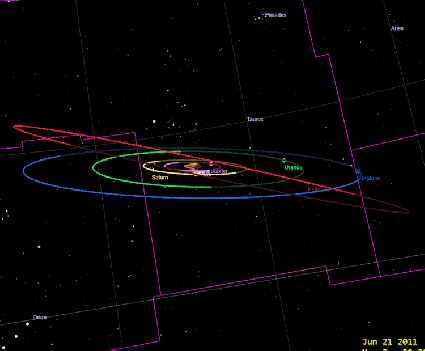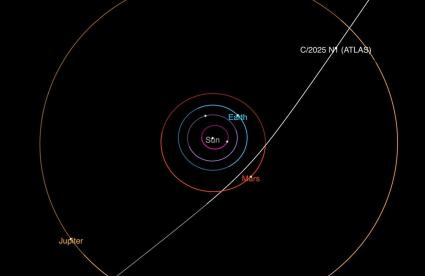A Comet From Another Solar System Is On Its Way

Solar systems mostly keep to themselves. What’s ours is ours and what’s not is not. Stars are simply too far from each other—four light years and change to our nearest neighbor—and too big and strong to allow things to escape their gravity well. But we know some things do make it out. And, seemingly very rarely, some things make it in. One’s on its way now. Everyone get ready to meet 3I/ATLAS, a comet that was likely born around some distant star, hurtling toward our inner solar system at about 130,000 mph and getting faster. It’ll be here this fall. Everyone try to look busy.
Most of the things we know about that can leave our solar system, we have built ourselves. The Voyager probes have both crossed what we (somewhat arbitrarily) have deemed the border of interstellar space, and two Pioneer probes, even though we’ve lost touch with them, are on their way. New Horizons will get there too.
But we also know the solar system can eject its own bodies, if things line up just right. In 1980, Edward Bowell discovered a comet with a fairly normal orbit around our Sun, which it had circled every seven million years or so since its formation, like all our comets, out in the icy regions beyond Neptune. But on this fateful trip, its orbit took it on a close pass of big, fat Jupiter, which accelerated it so much that its orbit became hyperbolic, meaning that it’ll inevitably escape the Sun’s gravity and cruise off into the blackness between the stars. C/1980 E1 (Bowell) won’t ever come back. It was the first comet, but not the last, that we’ve discovered taking a one-way trip.
The existence of C/1980 E1 (Bowell) carried capital-I Implications. As far as we know, there’s nothing special or unique about our solar system. If we have Jupiter and Saturn looming large enough to fling smaller objects into interstellar space, other solar systems with their own gas giants should be doing the same thing. Given the sheer number of solar systems out there (there are a few hundred billion stars in our galaxy alone), and the age of the universe, shouldn’t some of those distant objects have been flung, by pure randomness, directly at us? Why hadn’t we seen any of them?
Finally, in 2017, we did: 1I/ʻOumuamua, a total weirdo. Cigar-shaped, no coma or tail like a normal comet should have, moving too fast for us to really get a good look at it and figure out its deal. That led to plenty of out-there theories, including that it was an alien spacecraft, but no intelligence is necessary to explain it. It’s simply a long chunk of rock and ice that has been wandering the spaces between the stars of the Milky Way for hundreds of millions of years, likely taking a few turns around the galactic center, until pure chance sent it on a short and speedy jaunt through our neighborhood. We discovered it in October 2017, when it was already moving away from the Sun; 80 days later it was unobservable, and heading back to the emptiness from which it came.
We know relatively little about ‘Oumuamua, but a second interstellar visitor gave us a better look. Discovered in 2019, 2I/Borisov was clearly a comet, but one quite different from the ones we grow in our solar system. With very little water and a whole lot of carbon monoxide, a composition that is extremely rare around here, Borisov may well have been a very representative comet from whatever solar system it used to call home—possibly a star in the constellation Cassiopeia.

Enter 3I/ATLAS, just the third visitor we’ve ever spotted. On Tuesday, it was spotted by a telescope in Chile, part of the NASA-funded Asteroid Terrestrial-impact Last Alert System, which is intended to give us early warning about objects that might collide with Earth. Indeed, at first it looked like a rogue asteroid. But follow-up observations over the next 48 hours, including “precovery” images dating from June (if you know where a rock is going, you can figure out where it’s been, and look for it in old photos), proved conclusively that 3I/ATLAS is a comet, not an asteroid, and it’s moving far, far too fast—about twice as fast as either ‘Oumuamua or Borisov—to be anything but a visitor from outside the solar system.
We can’t say much about 3I/ATLAS just yet, other than that it’s clearly a comet (its healthy coma makes it extraordinarily bright, which is how it was spotted this early, just inside the orbit of Jupiter), and, curiously, it’s close to the ecliptic plane, in contrast to the two earlier visitors who entered from above. But we’ll get our chance to see. When 3I/ATLAS makes its closest approach to the Sun and Earth, between October and December, it’ll swing just inside the orbit of Mars, a mere 160 million miles from us. We’ll see how big it is, we’ll have a better sense of where it’s come from (broadly, from the direction of the constellation Sagittarius), and by the colors emitted in the outgassing of its dust, we’ll know what it’s made of. We are, very slowly but surely, helping to build a picture of how the matter in our solar system differs from others. Maybe it’ll turn out that we are kind of special.

Three visitors in eight years raises an even-bigger picture question: Are interstellar objects genuinely rare occurrences, or are they simply difficult to find? Going a long way toward answering this will be the work of the Vera C. Rubin Observatory, a massive new observatory in the Chilean Andes which began operation last month. It’s one of the most exciting projects in skywatching in years, because of the sheer capabilities of the thing:
A giant telescope, called the Simonyi Survey Telescope, is connected to the world’s largest and highest resolution digital camera. Rubin’s 27-foot primary mirror, paired with a mind-boggling 3,200-megapixel camera, will repeatedly take 30-second exposure images of vast swaths of the sky with unrivaled speed and detail. Each image will cover an area of sky as big as 40 full moons.
Every three nights for the next 10 years, Rubin will produce a new, ultra-high-definition map of the entire visible southern sky. With this much coverage, scientists hope to create an updated and detailed “movie” they can use to view how the cosmos changes over time.
Rubin, already spitting out incredibly dense and vast images of distant galaxies, should also be perfect for spotting smaller, nearer interstellar objects—possibly even before they reach our solar system. It should give us a sense of whether 3I/ATLAS and its two forerunners are true rarities, or if “empty” space is actually full of these silent wanderers, racing unseen through the dark until, eventually, we get in their way.






